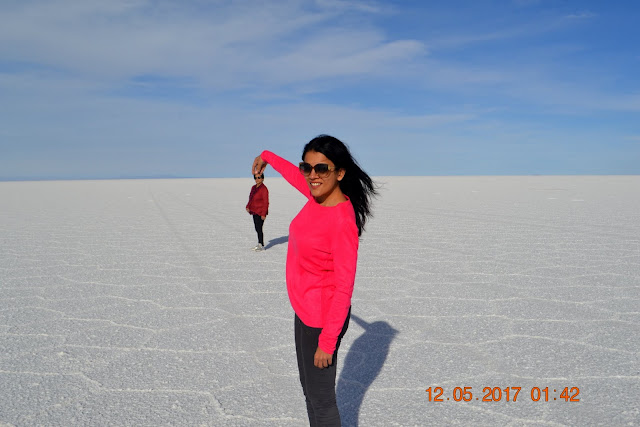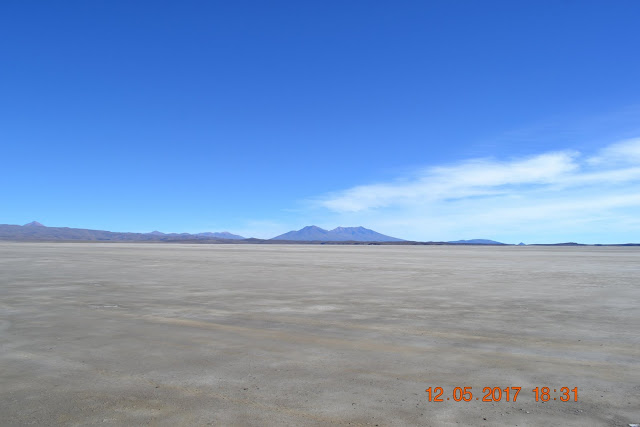Back to
blogging after a long time ……..
After a very
relaxing stay in Lake Titicaca we drove back to La Paz and spent a delightful
evening at the hotel. Very early next morning we took a flight to Uyuni,
located 410 Km South of La Paz. Uyuni is a small town situated in the middle of
nowhere which acts as a staging post for tourists visiting the salt flats. Tourism
is the main source of income.
We booked
with the ‘Red Planet Expeditions’ for our three days tour of the salt flats.
Salar de Uyuni is part of the Altiplano of Bolivia. The Altiplano is a high
plateau, which was formed during uplift of the Andes Mountains. The plateau
includes fresh and saltwater lakes as well as salt flats and is surrounded by
mountains with no drainage outlets.
Figure 1 - Fascinating trip
Visiting salt
flat was a major item in our must do list. Friends who had visited the Salt
flats had cautioned us about the extreme conditions under which we have to
travel. Uyuni is located at a height of 12,000 ft and the tour reaches a height
of 16,600 ft. In addition to the omnipresent altitude sickness we had to face
sub zero temperature and extremely strong wind. Due to its desolate and remote
location, the Red Planet had warned us in advance about our extremely basic accommodation
and food.
Four of us
and two youngsters from Netherlands travelled together in a Toyota land cruiser.
After an extensive briefing we departed Uyuni. The salt flats are one endless
sea of salt covering a mind blogging 10,582 square kilometers. It is covered by
a few meters of salt crust, which has an extraordinary flatness with the
average elevation variations within one meter over the entire area of the
Salar. The crust serves as a source of salt and covers a pool of brine, which is
exceptionally rich in Lithium. It contains 50 to 70% of the world's known lithium
reserves. The Salar is virtually devoid of any wildlife or vegetation. The only
vegetation that can be seen is the giant cacti reaching up to 40 feet.
On a still day, the thin layer of water covering the salt forms a giant
mirror reflecting the sky.
Travelling
endlessly from one attraction to another was an integral part of our visit. In
all we covered 1400Km of salt flats in three days. We stayed in houses entirely
built with salt bricks, including the dining tables, chairs and beds. We chewed
lots of coca leaves to overcome high altitude sickness, drank endless amount of
water and ate very frugally throughout our stay. Sleeping was yet another big
issue. In spite of four layers of clothing, blanket and a sleeping bag, nights
were unbearable. The mirror like flat surface gave us unlimited opportunity for
trick photography. The temperature
varied from +5 to – 4 deg C. The strong wind tears into your body. One must
always park your car facing the wind or risk your door being blown away with
the wind as one tries to get out of the car. I endured a bit of gum bleeding at
16,600 ft on top of an extinct volcano. We were able to frequently sight the
local animal life – James Flamingo, Culpeo. Llama and Alpaca. Incidentally
James Bond film “Quantum of Solace” was extensively filmed in the Salt Flats.
The most
fascinating aspect of our trip was the images of snow capped mountains, hills
in various hues of colours entrapped between clear blue skies and the salt
flats. Watching sunset and gazing at the star filled night sky also kept us
busy.
In spite of
all the hardship, visit to the salt flats was a rare and memorable experience.
Day 1
Figure 2 The companions
“Great Train
Graveyard”
Uyuni has
long been known as an important transportation hub in South America and it
connects several major cities. In the early 19th century, big plans were made
to build an even bigger network of trains out of Uyuni, but the project was
abandoned because of a combination of technical difficulties and tension with
neighboring countries. The trains and other equipment were left to rust and fade
out of memory.
Figure 3 At the graveyard
Figure 4 Getting Cozy
Figure 5 Sushama all excited
Figure 6 - Rail tracks to nowhere
Figure 7 - Futile attempt
Figure 8 – Alpacas grazing
Colchani
to witness how the salt is processed.
Colchani is a tiny, one street town situated on the edge of the Tunupa
Salt Flat, 80 km (50
miles) northwest of Uyuni. The only salt-making facilities using salt from the Salar de Uyuni are
located in Colchani – a cooperative joint-owned by all salt workers. There
is an estimated 10 billion tonnes
of salt contained in the Salar de Uyuni, with around 25,000 tonnes excavated
and processed at Colchani annually.
Figure 9 - A typical salt house
Figure 10 - Colorful market place
Figure 11 - At the factory
Figure 12 - Mine owner busy with his work
Figure 13 - A salt monument
Playa
Blanca salt hotel
Figure 14 - Posing after a good lunch
Figure 15 - Flags on display outside the hotel
At the Salt Flats and crazy
photography
Figure 16 - Evolution of humans
Figure 17 - Carrying my travel companions
Figure 18 - Jurassic experience
Figure 19 - Wine break
Figure 20 - Lifting Rita
Figure 21 – It can’t get any better - a roll on
the bottle
Figure 22 - A spoonful of lunch
Trichocereus cactus
For most
Salar de Uyuni tours, the main destination is the spectacular Isla Incahuasi,
otherwise known as Inkawasi, in the heart of the Salar 80km west of
Colchani. This hilly outpost is covered in Trichocereus cactus and surrounded
by a flat white sea of hexagonal salt tiles.
Figure 23 – Amazing growth of cacti
Night view
Figure 24 - Jumping with joy
Figure 25 – Chances of confusing the plains with
sea
Day 2
Chiguana
desert- We visited Sol de Mañana
This desert
is surrounded for many volcanoes…like dormant ones, extinct ones . We visited Sol
de Mañana, meaning Morning Sun in Spanish,
which is a geothermal field in south-western Bolivia.
It stands at a height of 16,600ft. The short stay was punctuated for me when I
started to bleed in the gums. The guide had to rush me down to lower altitude
to stop the bleeding.
Figure 26 - At a distance
Figure 27 - Photo op
Figure 28 - The geyser point
Figure 29 - Incredible sights of the Andes
Andean lagoons
Flamingos
gather here by the hundreds to drink the mineral rich water
Figure 30 - A lovely sight
Lunch at the
Echo Hotel
Figure 31 - Very colorful to contrast the desert
Figure 32 - Beautiful Bolivian Lady
Figure 33 - Very basic and frugal lunch
Figure 34 - A lonely Culpeo
Figure 35 - Captivating beauty
Figure 36 - Unforgettable sights
Figure 37 - Sharing a quiet moment
Figure 38 - A memorable trip. drive back








































Enjoyed the trip at no cost!
ReplyDeleteVery informative.
Thanks for your support
Delete